- Products
- Use Cases
- Process contractors and validate credentials
- Improve facility compliance to industry standards
- Improve speed of visitor check-in process
- Screen visitors or restrict access to my facility
- Automate my reception experience
- Improve and automate my facility evacuation process
- Manage facility security across multiple locations
- Industries
- Pricing
- Resources
- Company
The Complete Enterprise Emergency Management Guide
September 28, 2022
In a perfect world, you would never have to use your emergency management platform. But you can't rest your facility's health, safety, and security on faith and good fortune. When the unthinkable happens, a proactive emergency operating system is the best line of defense for your building and the people inside.
Too many organizations suffer from reactive and outdated emergency solutions, hampered by disorganization and poor communication. It is beyond time that enterprise facilities take control—upgrading to proactive measures to improve the capacity for emergency management and response personnel.
This guide explores innovative emergency management strategies and how to apply leading solutions and software in your facility.
What is Emergency Management
Emergency management is the framework that dictates how an organization handles emergencies. It involves all aspects, from emergency preparedness and prevention to the actual response and recovery when an emergency occurs.
The function is performed through the combined efforts of people, processes, and platforms. Enterprise emergency management is complex and may involve multiple locations and emergency managers. To streamline processes and enhance organization, enterprises rely on comprehensive emergency management software.
The best emergency management software is designed to handle a variety of potential threats and incident types.
Potential Threats in Enterprise Incident Management
A facility with the capacity for emergency management and response personnel to take proactive, effective actions, requires preparedness for all types of incidents. Potential threats can range from intentional, incidental, or acts of nature. Some potential threats include:
- Biological
- Human
- Environment
- Utility
- Cyber
Biological
Biological threats can present a significant risk in your building, affecting employee health and potentially causing operations to shut down. The COVID pandemic is the most obvious example of this in the modern era.
Facilities can take proactive emergency precautions with screening protocols at sign-in. At its simplest, this can include prompting COVID or other health risk screening questions as part of the visitor registration process. Kiosk cameras can scan QR codes for vaccine passport validation during induction. Thermal cameras can add a further layer of safety to the visitor kiosk, checking visitor body temperatures.
Human
Human threats are a particular concern in high-security facilities (i.e., defense or government) and industries with vulnerable people, such as education. Setting up custom or integrating official denied party lists helps to mitigate risk. Your system automatically flags potential risks alerting security or denying entry.
Not all human threats are external, nor intentional. Human error and accidents can lead to security breaches, fires, and other potential risks. In these events, you need a secure way to track who is in your building and manage evacuations.
Environmental
Earth, Wind, and Fire won't always be a Boogie Wonderland. Environmental threats, from extreme weather to earthquakes, floods, and fires are enormous threats to the safety of your facility and visitors.
In these events, you must assign appropriate mustering points for the given emergency type. You also need evacuation tracking and communication tools to ensure safety and enhance the effectiveness of first responders.
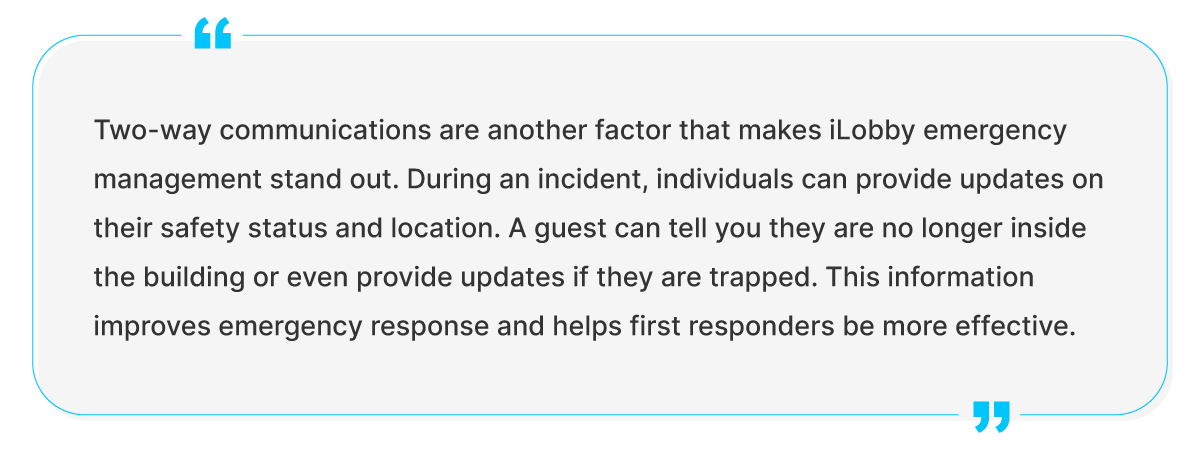
Utility
A common secondary effect of environmental emergencies is a loss of utilities. Utility failures can greatly impact a facility, regardless of its cause. Even temporary power or internet loss halts productivity, potentially costing tens of thousands per minute. Having an emergency plan for utility failure, such as backup generators, can reduce loss. They are also necessary for industries like hospitals and healthcare, where power is essential for life and safety.
Other utility emergencies, such as gas leaks, are immediate safety threats to your visitors and employees. Emergency communication and notification of authorities must be prompt and clear.
Cyber
Every modern facility and enterprise has potential vulnerabilities to cyber threats. Cyber-attacks like phishing, malware, and ransomware are on the rise. Employees need training on safe practices with digital devices and software – such as how to spot phishing, create safe passwords, and the appropriate use of technology.
Organizations themselves also have a significant responsibility to protect sensitive data. Not only does this protect intellectual property and individuals, but it is necessary to meet local regulations. GDPR-compliant software helps secure sensitive data and prevents fines and penalties from regulatory agencies.
The 4 Phases of Emergency Management
An effective emergency operating system requires forethought. Even with automated safety systems and software, a human element is required during planning and implementation. As such, the incident management process must begin with a clear understanding of the four phases of emergency management.
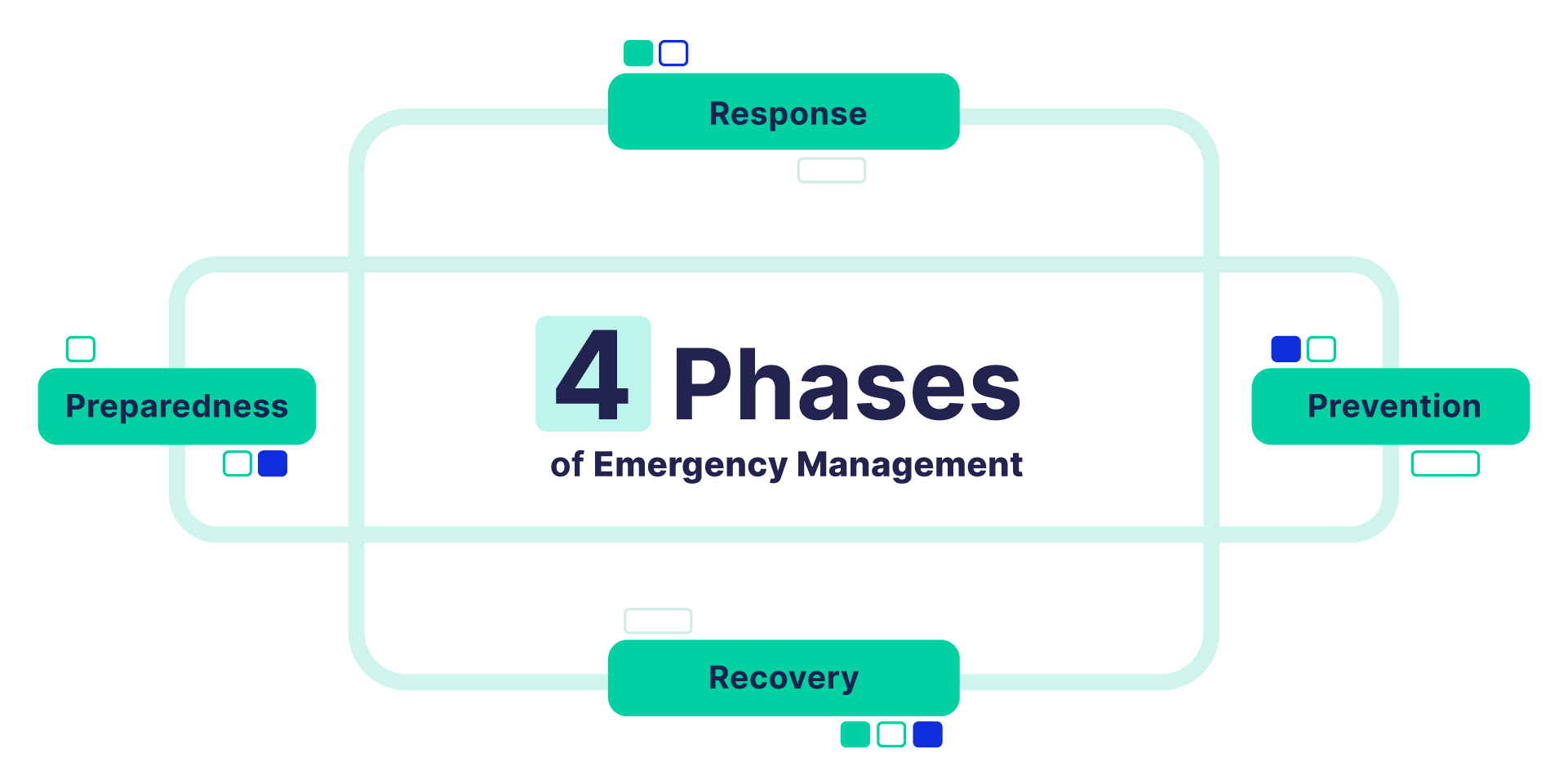
1. Preparedness
Emergency preparedness in the workplace starts with creating an emergency response plan. An emergency preparedness plan is essential for facility management in every industry. Facilities need clear, established plans and standard operating procedures to deal with potential incidents.
Incident management preparedness should consider the unique emergency types for the region, climate, and industry type. For instance, downstream oil and gas managers must address potential fire and explosion risks. Climate and regional threats could include freezing or extreme weather that could knock out power or cause physical damage.
Once aware of what types of emergencies a facility may face, environmental health and safety teams must implement strategies and software to respond and prepare for incidents. To prepare for response, a complete emergency preparedness checklist is a must.
Emergency Preparedness Checklist
- Planning: Planning involves an all-hazards risk assessment to identify threats, then determining the necessary elements to prevent, mitigate, and respond to emergencies.
- Training: All relevant employees, EHS, and security personnel need training on the procedures and software used in emergency response and prevention.
- Exercises: Keep your facilities ready for potential risks with routine exercises, like fire drills and alarm testing. If disaster strikes, you know your organization is prepared.
- CAIP: A Capability Improvement Process assesses responses and examines data to improve upon your emergency preparedness plan using information from exercises and responses.
- Communication: Powerful emergency communication tools are critical. Send emergency notifications and alerts to everyone in your building and establish two-way communication for safety check-ins.
2. Prevention & Mitigation
With potential threats identified, we can move on to the prevention and mitigation phase of emergency planning. Prevention is always worth the effort. Avoiding emergency evacuations, work stoppages, and safety hazards is the safest and most cost-effective outcome of emergency management. Achieving this result requires a system of checks and balances.
Conducting watchlist screening is a good example of implementing checks and balances into your emergency management system. In sensitive industries like government and defense, implementing denied party lists drastically enhances workplace security. A visitor sign-in system can automate screening, identifying people on custom or official watchlists. Some examples include:
- Terrorist & no-fly lists
- Sex offenders
- People and organizations convicted of export trade violations
Once identified, security can receive automatic notifications of the potential risk, sign-in and visitor badge printing halts, and they can deny access from an online portal. This response prevents risks from known human threats while easing ITAR compliance and other regulations.
Things happen. Even with comprehensive preparations, it is impossible to have standard policies and procedures for every outcome, especially in emergencies. Where absolute prevention is unachievable, mitigation emergency management strategies are still possible. Emergency mitigation services reduce the cost to health, life, organizations, productivity, and the environment.
When a specific emergency type occurs, mitigation can include:
- Having a clear chain of command for emergencies
- Knowing which agencies to call (fire, police, ambulance, utility)
- Having appropriate safety equipment (ex., shut-off switches, fire extinguishers, release valves)
- Training employees and EHS teams
- In house response teams such as emergency response maintainers and hazmat teams
- Emergency communications (mass notifications, digital mustering)
Emergency mitigation and prevention plans are most effective as proactive measures but can also include preplanned reactive responses.
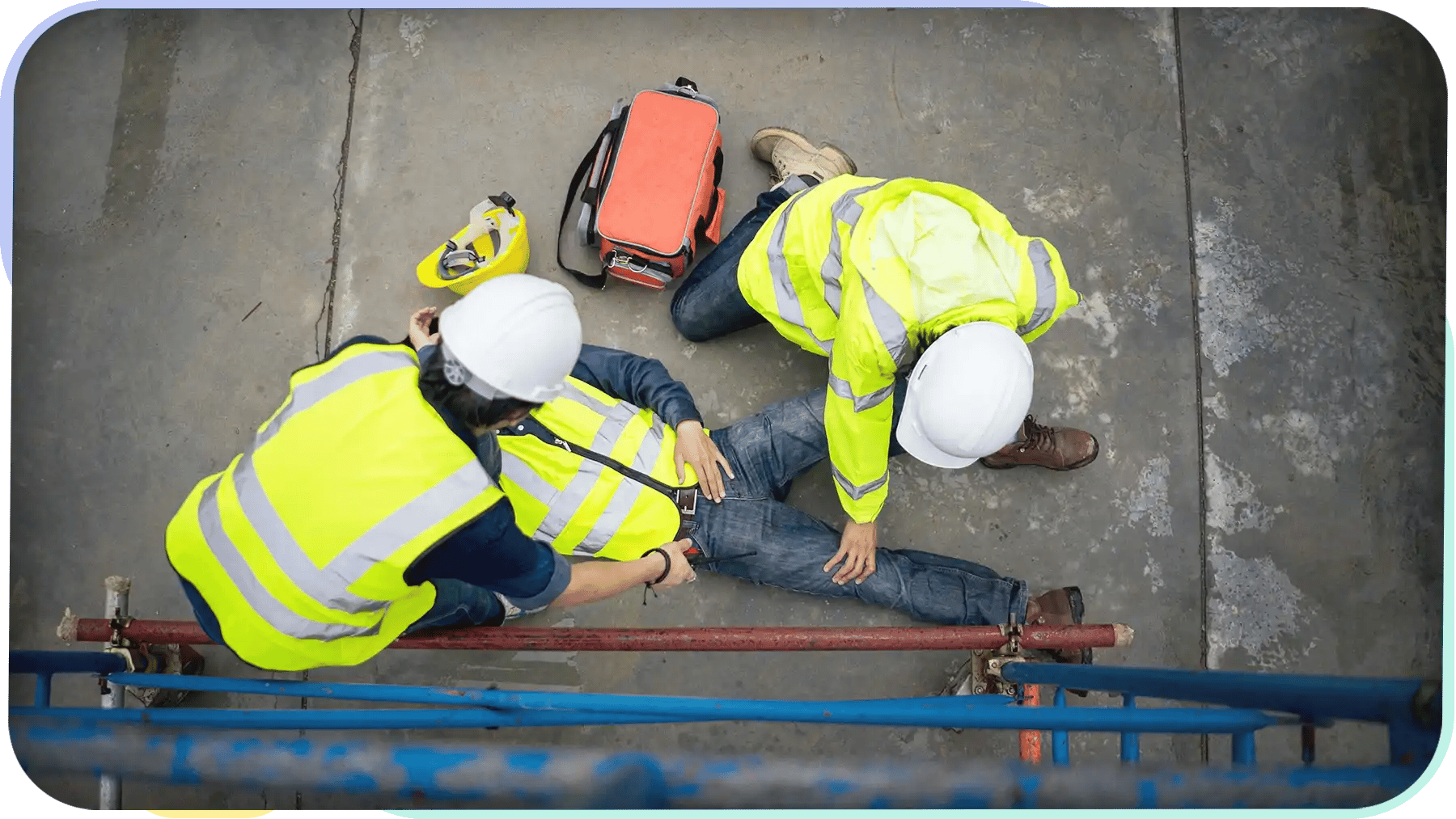
3. Response
An emergency response system determines how you react when an emergency occurs. The first step is typically implementing the emergency mitigation plan for your workplace. Alert all staff and visitors in your building about the emergency and type and send out essential mustering and evacuation information.
Alert the necessary authorities, internal teams, and response systems for rapid response. A fast, clear, predefined response reduces potential risks and losses during an emergency.
Although an effective emergency response plan starts by implementing proactive measures, it must remain reactive and adapt to changing situations. Incidents occur quickly and can change or escalate with little warning. Achieving this relies heavily on training and preparation, as well as relying on experts for their experience.
4. Recovery
After an incident occurs and the response actions are complete, we move to the fourth phase of emergency management – recovery. Emergency recovery aims to restore your facility to its pre-incident state.
The first steps of emergency recovery are restorative.
- Rebuild damaged infrastructure and machinery
- Clean up spills, debris, and hazardous materials
- Prepare for the reopening of closed areas
- Hire new or temporary staff to fill any gaps
- Return to work
Having an emergency recovery plan already in place helps to clear up the confusion about what to do after an emergency. It also provides direction in a time of turmoil. As a result, a recovery plan helps us return to normal faster, reducing losses in productivity.
After completing the initial recovery phase, we return to the emergency preparedness phase. Looking at the emergency response results and reviewing what aspects could use improvement allows EHS and facility managers to better prevent, mitigate, or respond to future incidents.
Emergency Planning 101
Facility managers and security teams must know how to plan for workplace emergencies and evacuations. An effective emergency management plan is unique to your facility and industry. Even still, all EM planning should follow the same basic principles and steps. Here we discuss how to get started.
The 8 Principles of Emergency Management Planning
The Federal Emergency Management Agency (FEMA) lists eight principles that should describe your facility's emergency management plan.
- Comprehensive: All hazards, phases, and people affected by or involved in emergency management must be accounted for in emergency planning.
- Progressive: Planning should look forward, anticipating necessary measures for prevention and preparation.
- Risk-Driven: Risk management is a primary focus, identifying hazards, potential risks, and outcomes of emergencies. Risk assessment should inform the resources and strategies employed in emergency preparedness and response phases.
- Integrated: Emergency management should involve EHS, government authorities, tools and software, and the community.
- Collaborative: Support internal and external relationships with all organizations and individuals that may be necessary to manage emergency planning, response, and recovery.
- Coordinated: Use a big-picture approach to consider how each person and organization fit into your emergency plan. Ensure responsibilities, communication, roles, and connected tasks are clearly defined and assigned.
- Flexibility: Flexible, adaptive problem-solving is a necessity for effective emergency response. Approaches to response and prevention should be unique, innovative, and adaptable.
- Professional: Emergency management is executed on the foundations of knowledge and science. Develop training, practices, and employment on these principles.
A 6 Step Guide to Emergency Management Planning
1. Risk Assessment
Emergency management has two types of assessment: risk assessment and rapid assessment. The former comes into play before an emergency occurs, and the latter in response to the emergency itself.
A proper risk assessment incorporates hazards and vulnerabilities.
Hazards are the actual threats:
- Events (i.e., floods, fires, active shooter)
- Physical agents (i.e., heat, cold)
- Biological entities (i.e., virus outbreak)
Vulnerability measures the predisposition a facility, section, or activity has to various hazards. The more susceptible to a hazard a process is, the greater its vulnerability. Risk refers to where hazards and vulnerabilities intersect.
The first step of risk assessment is a hazard assessment (what hazards are present, likely, or possible?). Next, identify who or what is at risk due to the hazard. Finally, we conduct the vulnerability assessment, which explores how vulnerable each element is and what factors influence that vulnerability.
A vulnerability assessment measures vulnerability by looking at the intersection between the four levels of resilience and the four levels of susceptibility:

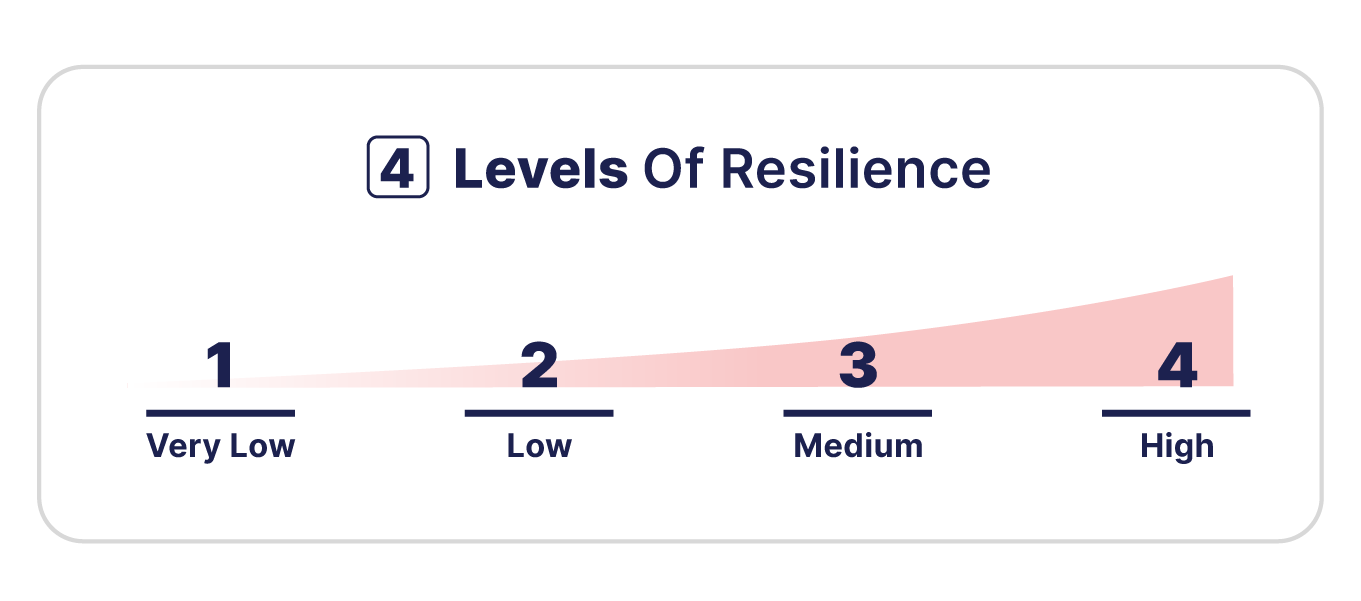
The greater the susceptibility, the greater the vulnerability. The greater the resilience, the lesser the vulnerability. So, a highly vulnerable element would score a high susceptibility level and a low resilience level.
We conduct the needs assessment only once the risk assessment is complete with the identified hazards and vulnerabilities. The needs assessment is what is required to respond when an emergency occurs. A fire risk, for example, is likely to have a fire department response as part of its needs.
2. Roles
The next step is establishing your workplace emergency response team roles and responsibilities. Consider who needs to be involved in your emergency response and preparedness, their tasks, and coordination.
The health and safety officer and security teams are often responsible for the majority of, and most important, roles. Roles may include elements from all four phases of emergency management, and a single individual may have duties in each phase.
Each role must be clearly defined and communicated. The individuals responsible require adequate training on the processes and emergency management software used in each role.
3. Technology
Maintaining preparedness and ensuring swift, effective emergency response requires sophisticated technology. Emergency management software enhances the capacity for emergency management and response personnel.
Look for tools that provide automation, creating digital visitor logs and real-time monitoring. These enable a quick view for immediate action, communicate safety and evacuation messaging, and provide incident management situation reports. Emergency reporting software not only helps manage incidents as they occur but allow for making improvement or responding to audits after the fact.
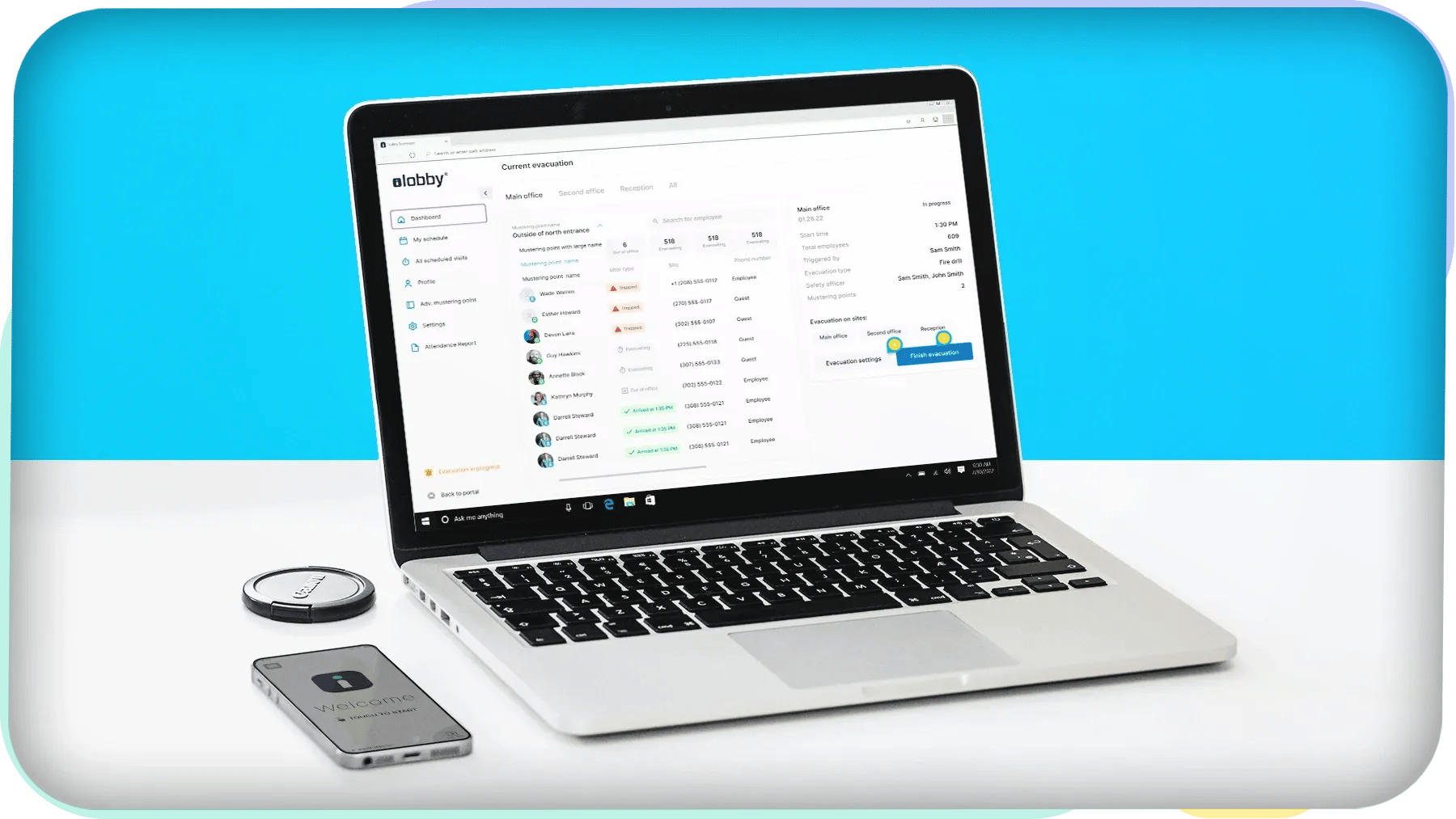
4. Procedures
An important part of emergency management mitigation and preparedness is developing SOPs (standard operating procedures). An emergency SOP provides step-by-step instructions on how to respond to specific incidents.
A clearly defined process ensures a uniform response that is timely and effective. There is no need to go through extra steps for communication or approvals, so the emergency response is efficient and predictable.
An SOP includes who is involved in the procedure, what emergency management software and technology is used, and the individual steps of the process. You must clearly define all roles and objectives to create an emergency management SOP.
5. Implementation
The implementation of your emergency management plan is two-part. The first is getting all the pieces of your plan in place. Ensure any emergency management software or systems are installed and active. All roles are assigned and communicated. Procedures and processes are clearly defined, and those responsible have adequate training.
The second part is implementation during an actual emergency. Your emergency management coordinator has done their work, and now it's time to see how your plan performs in game-time conditions. No matter how successful your emergency management plan is, it is always a learning process you can use for future improvements.
6. Innovation
A good incident management process is never static. Emergencies are dynamic, so health and safety officers need to look for constant improvements and innovations. Keeping tabs on evolving tools and technology is important for keeping ahead of risks. It's also important to look at the data from your past emergencies and drills.
Look for any hiccups, challenges, or opportunities to improve your existing processes. Common issues include communication failures, undertraining, or poorly defined roles. Look at your data and patterns to determine what needs improvement and what steps to take. Do you need to run more drills, expand responsibilities, or incorporate new emergency management software?
Must-Have Features of Emergency Management Software
You need tools that offer rapid, reliable responses when incidents occur. The best emergency management software achieves this by relying on automation and integrations. Your emergency management system centralizes all activity and monitoring through a centralized platform.
Here we discuss some of the most important features to look for when choosing emergency management software.
 Digitized Mustering
Digitized Mustering
Establishing muster points and emergency mustering procedures is crucial to the safety of personnel during incidents.
A digital mustering system provides immediate information to everyone in your building using real-time monitoring. Employees, visitors, and contractors receive messages with incident-specific muster points. This ensures they know where to go and assemble at a safe location considering the specific emergency type.
Having everyone assemble at muster points reduces the strain on resources and first responders. As a result, responses are faster and more effective. Advanced mustering through emergency management software keeps your facility and personnel safe. Achieving the speed and reliability necessary requires emergency mustering tools that are organized and automated.
Powerful Communications
Communication is a critical factor for navigating emergencies. When an incident occurs, you need an emergency mass notification system to alert everyone in your building immediately.
With iLobby, security or health and safety officers can start and manage emergency notifications directly from the kiosk or from the online portal. It enables rapid response and even offsite emergency management. Teams can also set triggers to send automatic emergency notifications and messages.
Ensure no one misses an emergency alert with multi-channel communications. Individuals can choose the best way to reach them, such as by SMS, email, or Slack, so they always receive notifications.
Two-way communications are another factor that makes iLobby emergency management stand out. During an incident, individuals can provide updates on their safety status and location. A guest can tell you they are no longer inside the building or even provide an update if they are in need of assistance. This information improves emergency response and helps first responders be more effective.
.webp?width=1800&name=Visitor_Monitoring%20(1).webp)
Evacuation Tracking
A mobile emergency management app enables real-time evacuation tracking. Send out automated roll calls via SMS, send mustering information in an instant, or even allow individuals to request assistance. Stay aware of who is in your building, who is safe, and who needs help.
Seamless Integration
Your organization already has an existing tech stack. You need an emergency management platform that works with your tech stack instead of replacing it. iLobby software integrations work with the most commonly used business tools.
As a result, our software avoids duplication of efforts and miscommunication. It also improves ease of adoption as the integrations work with the tools your team already knows how to use. Our emergency operating system also works directly inside our facility management platform. You can easily manage all aspects of facility management under one centralized dashboard.
Liability Mitigation
Proactive emergency preparedness safeguards your visitors and your organization. Ease compliance with regulatory agencies with automated visitor management software. When visitors and contractors sign in, prompt them with important safety information and collect digital signatures for legal documents.
The system also automatically provides relevant employees and safety officers with real-time data of every sign-in.
Safeguard Your Facility with Enterprise Emergency Management Software
The iLobby emergency management portal is a turnkey solution to protect your personnel, data, organization, and infrastructure. A module within our facility management platform, our emergency operating system improves emergency response and eases compliance with a turnkey solution.
Discover the iLobby difference with EmergencyOS.
Related Posts
View All Posts
Emergency Management
6 min read
Muster Point Meaning & Best Practices: Emergency Management FAQ
Continue Reading
Emergency Management
4 min read
How to Speed Up Emergency Response Times in Your Facility
Continue Reading
Emergency Management
5 min read


